Wieambilla inquest: Radios kept dropping out as police raced to Wieambilla shooting
The brave officers who went straight into the line of fire at the Wieambilla massacre had major black spot issues with their radio and communications devices, an inquest was told.
Police & Courts
Don't miss out on the headlines from Police & Courts. Followed categories will be added to My News.
Police who rushed to the Wieambilla massacre within a minute of hearing about it had major black spot issues with their radio and communications devices as they got closer to the home of a trio of conspiracy theorists, an inquest has been told.
A marathon inquest into the murders of police officers Rachel McCrow and Matthew Arnold, good Samaritan Alan Dare and the shooting deaths of Nathaniel, Gareth and Stacey Train began in Brisbane on Monday.
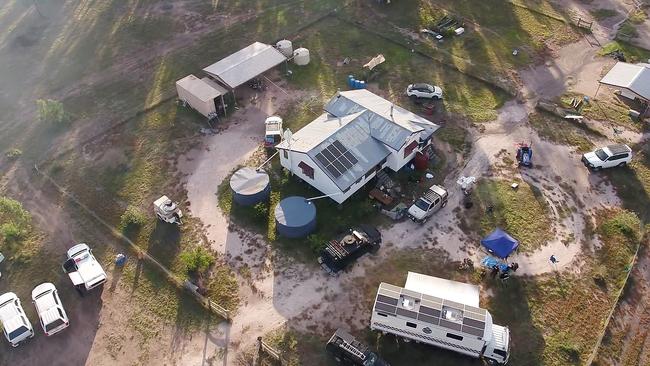
The two constables were killed by the trio within minutes of their arrival at the Trains’ Western Downs property on December 12, 2022.
The four officers were there to conduct a missing persons inquiry but instead were ambushed by the Trains, who had set up sniper hides to lay in wait for police, who they considered to be the enemy.
Neighbour Mr Dare was killed by the Trains when he saw smoke coming from their property and came to investigate.
ONE OFFICER “HUNTED”, ANOTHER “PLEADING FOR HER LIFE”
A senior officer has told an inquest he made a decision to send a team in to rescue injured or trapped police from Wieambilla rather than wait for highly trained SERT operatives after hearing one was being “hunted” and another was “pleading for her life”.
Inspector Timothy Mowle was working from Charleville police station when he heard officers had been shot at Wieambilla – a five-hour drive away.
He told the inquest he began making calls, including one to put Inspector Wayne Rasmussen in charge of the forward command post, before making his way to the scene himself.
He said he got in touch with the Special Emergency Response Team commander to request their attendance at Wieambilla but learned they were already mobilising.
Insp Mowle said he was told a team was on board a police helicopter but would not arrive on scene until approximately 7pm.
Other teams were responding by road.

Insp Mowle said he continued to make calls to get updates and organise police resources.
At 6.19pm, he said he was told by Insp Rasmussen that Constable Brough was hiding and on the phone to Triple 0 and that she was “uninjured (but) being hunted by the pair”.
Referring to call logs and diary entries, Insp Mowle said he was told “they’ve set the grass on fire to flush her out, they’ve heard Rachel pleading for her life”.
He said they then discussed the possibility of taking “emergency action” – sending a rescue team in rather than wait for the arrival of SERT.
He said he spoke to the SERT commander again shortly before 6.30pm and was told the helicopter team was 30 minutes away and road teams 90 minutes behind that.
Insp Mowle said he asked the commander his thoughts on going in to rescue the stranded officers.
”I asked for his thoughts on how we should best deal with that,” he said.
Insp Mowle said the advice was to advise Keely to remain hidden but he came to the conclusion that the situation “time critical” and emergency action was needed.
”Things had reached a critical point and it was necessary for non-SERT operatives to go in and get Keely out?” Ms O’Gorman asked
”That’s correct,” Insp Mowle said.
“We’re time critical. From the time we got this it was time critical.
“She’s (Constable Brough) hiding, she’s being hunted, they’d set fire to the grass to flush her out (there were) grave fears they’d soon locate her.
“They’d heard Rachel pleading for her life. It’s all time critical.”
Insp Mowle said he attempted to call Insp Rasmussen and eventually got hold of Acting Sergeant Justin Drier on scene.
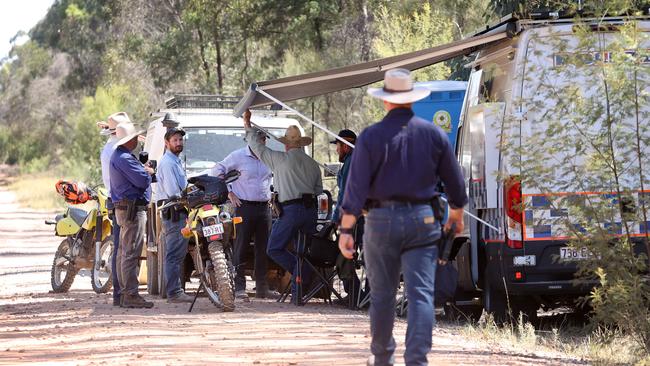
He told the inquest he’d planned to give the order to send in a rescue team but was told it was already underway.
He said he spent the next 13 minutes on the line getting updates in “real time”.
“I was asking him a series of questions, do they have eyes on, can they see Keely?” he said.
He said he was told “no, they can hear her” then “they can hear Keely singing out … she’s running … they have Keely out and they’re outbound”.
Insp Mowle said he was then informed the bodies of Constables Arnold and McCrow had been retrieved, saying he was initially told that one was dead and one may be critical.
Inspector Mowle said he wasn’t involved in the decision about whether police should try to go back for Mr Dare.
He said he became aware about Mr Dare’s death just after 8pm, after speaking with Inspector Rasmussen.
“He provided me assurance he was clearly deceased,” he said.
“I confirmed that he had been examined by an officer and the words used were I believe ‘clearly deceased, unable to be retrieved due to being exposed to rifle fire’,” he said.
“I agreed with Inspector Rasmussen that the risk of sending our officers back in there, if we were satisfied he was clearly deceased, there was no benefit to gain from that time.”
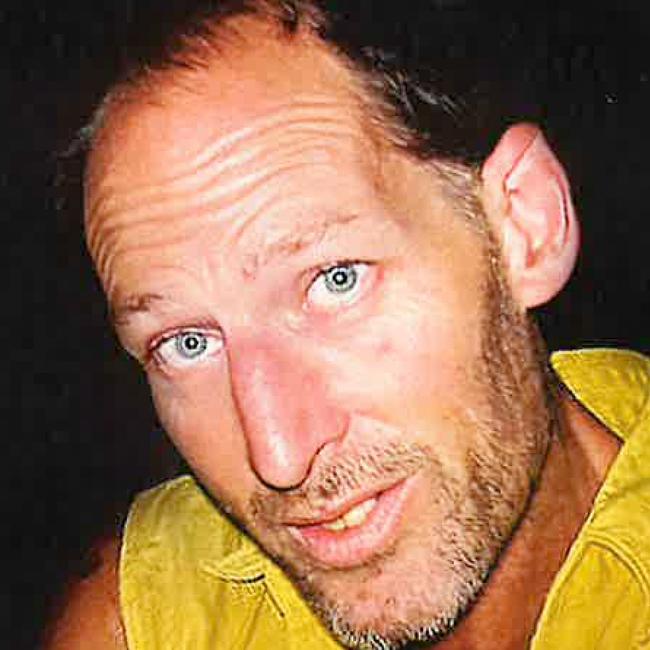
Inspector Mowle said there were some challenges with the police response because of where the incident happened.
“The greatest challenge we had was the geographical location, the tyranny of distance,” he said.
Insp Mowle said there were issues with communication black spots during the incident but that despite the challenges important messaging did get to officers in a “timely fashion”.
Over the incident he said he had to change through three separate radio channels.
EXCLUSION ZONE TO KEEP PUBLIC SAFE
Western Downs patrol Inspector Wayne Rasmussen, giving evidence before the inquest, said he made the decision to make a Public Safety Preservation Act declaration.
The alert, making the public aware that an emergency situation was ongoing within a certain boundary, went out to the media and publicly shortly before 6.30pm.
He said he decided against including information about an active shooter incident or saying there’d been “shots fired”.
”I asked not to because it was way too early for me in terms of my appreciation and situational awareness,” Insp Rasmussen said.
He said while being driven to the scene, he made an announcement over the radio that he was “taking control” of the incident.
”I needed it to be succinct (and) easily understood,” Insp Rasmussen said.
”(I said) all units were to resolve this incident as safely as possible, to retrieve injured persons without compromising their own safety and to exercise extreme caution,” he said.
Insp Rasmussen said he arrived at the forward command post at 6.47pm.
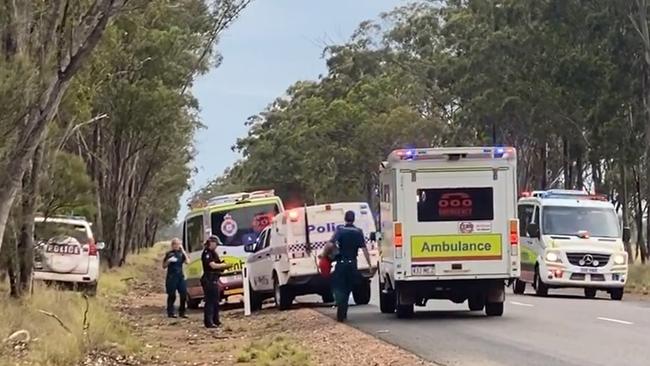
Inspector Rasmussen said communication had dropped out on the journey and he was not able to get in touch with Sergeant Werner Crous at the forward command post about plans to get the officers out.
The two officers had started talking about “how to progress” the situation when communications were cut off.
He said by the time he arrived some members of the extraction team had already returned to the forward command post with the plan implemented by Sgt Crous.
Constables Brough had been rescued and constables McCrow and Arnold had been taken from the Trains’ property.
“He had come up with the same conclusion,” Inspector Rasmussen said.
“Whether he heard my commander’s intent I’m not sure.”
“TOO DANGEROUS” TO RETRIEVE ALAN DARE
Insp Rasmussen said he had been at the forward command post for an hour when he asked whether anyone had told Mrs Dare that her husband had been killed.
He said he was aware she was across the road and that she was “quite upset”.
Upon being informed she had not been told, Insp Rasmussen said he took it upon himself to speak to her.
“I didn’t think it was appropriate to give a job like that to a subordinate,” he said.
He said he thought it best the most senior person on scene be the one to speak to Mrs Dare.
“I left the forward command post and walked across to where she and others were staged and delivered that sad message,” Insp Rasmussen said.
“Mrs Dare, her legs went out from under her … she was upset and she said that can’t be true – he must be alive.
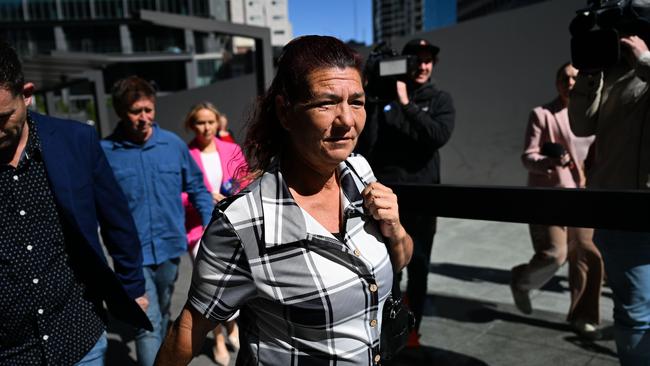
“I had to confirm with her that he was in fact deceased and there was no assistance that we could provide.
“I said it was too dangerous to push police forward at this point to retrieve him.”
Inspector Rasmussen said as soon as SERT handed back the scene to him at 1.07am he sent a detective to stand with Mr Dare.
“And we also covered Mr Dare at this point,” he said, adding it was a matter of respect to him.
“We provided a towel. We didn’t have sheets at that stage. It seemed a respectful thing to do.”
Inspector Rasmussen said once Mr Dare had been taken back to the command post arrangements were made with Mrs Dare so she could say her “final goodbyes”.
When constables McCrow and Arnold and Mr Dare were taken away from the scene police formed a guard of honour.
“There were fewer people there at that time,” Inspector Rasmussen said.
“Those of us that were there, we lined up and saluted all three.”
When asked if there would have been advantages or disadvantages with sending out a community alert after the shootings, Inspector Rasmussen said there would have been at least one.
“The advantage would have been the people who hadn’t heard the QPS announcements, may have received a message,” he said.
But Inspector Rasmussen said from his previous experience in disaster management it would have taken 45 minutes to send a message.
RADIO RECEPTION DROPS OUT ON RACE TO SCENE
Footage shown to the inquest shows the moment Dalby constables Mathew Owen and Christopher Sharman heard about the police officer shootings over the radio when they were in the town on another job.
“Urgent, urgent, shots fired,” Sergeant Justin Drier is heard saying on the radio.
“I have an officer down, repeat officer down.
“Can you go Code 1 to the location please. Any units?”
Within a minute of hearing about the shootings, constables Owen and Sharman left Dalby at about 4.42pm and arrived at the scene about 5.20pm, in a trip that would usually take about 70 to 75 minutes.
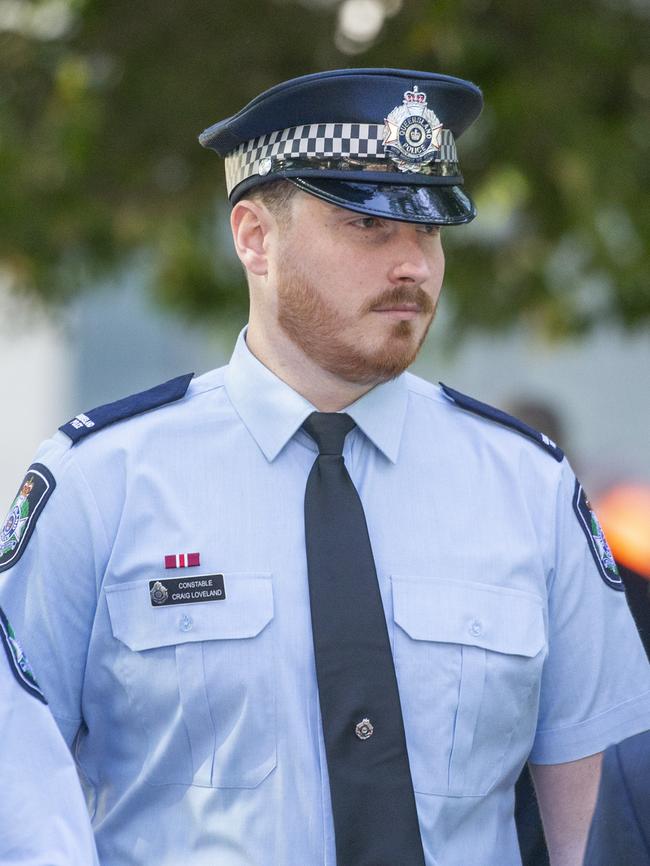
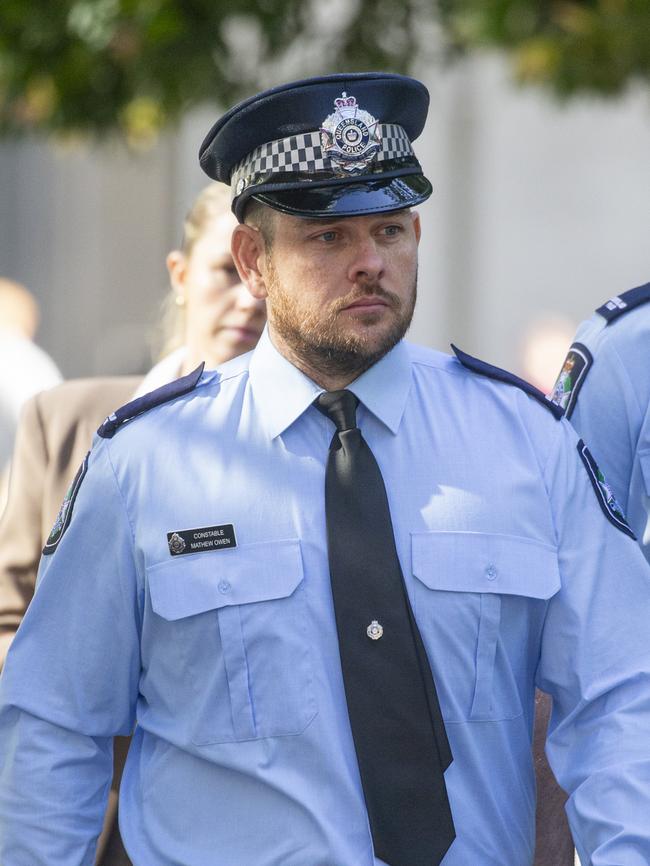
Constable Owen told the inquest that during the Code 1 emergency trip to Wieambilla, the reception dropped out regularly.
“There are known black spots where it always drops out but sometimes it can vary a little bit,” Constable Owen told the inquest.
“It had become more frequent as we got closer to the incident address. It was not so bad when we left Dalby and it progressively got worse.”
The officer said he would used a police iPad to look up details during a job but as they came closer the communications kept cutting out, as well as the radio.
They met with another officer from Tara police station, Constable Craig Loveland, near the scene.
“At that stage I knew that police officers had been shot,” Constable Owen said.
“There was a police officer who was unaccounted for. There was multiple shooters with rifles. And there was also a mention of a fire as well.”
When the arrived Constable Loveland told the officers that there had been “shots fired, officers down”.
“Possibly Rachel Arnold and one of the Chinchillas,” he told them.
“One of the Chinchillas (officers from Chinchilla) is out. I’ve been sitting here the last 20 minutes and they’ve told me don’t go in.”
The officers then began putting on ballistic vests.
Constable Loveland was asked by one of the Dalby officers what police were closer to the scene and he responded: “no one”.
“You won’t get through to comms, I’m letting you know, you won’t get through to comms,” Constable Loveland said.
Constable Owen said he and constables Christopher Sharman and Craig Loveland made the decision to drive to the front gates of the Train property rather than wait for other crews to arrive.
“We didn’t have a lot of information at that time,” he said.
“We knew there were shots fired, an officer was unaccounted for and we didn’t know how long any other officers were going to be.
“So rather than just sit there on the side of the road and wait for what could be ten or 15 minutes, we thought we’d go.”
Constable Owen said they were under the impression the shooters were contained on the Wains Rd property.

Body worn footage from Constable Loveland played to the inquest showed the officers arrive in two vehicles on the dirt road close to the front gates.
Constable Owen said he could see fire ahead and a blue car. The inquest heard it was Mr Dare’s car.
The footage showed a frantic Victor Lewis on a red quad bike approach the officers, saying: “My mate’s down there – he’s been shot in the back, I don’t know who’s shot him.”
“Mate, get out of here,” one of the officers could be heard shouting at Mr Lewis.
Constable Owen agreed the footage showed him saying “I want to get back” to his colleagues.
He told the court it was at that moment he realised the shooters were not contained within the property and their police cars would be a target to someone watching the road.
“I wasn’t aware that there was any activity or anyone had been shot outside of that property,” he said.
“When I realised it was at that car 20m away (that someone had been shot), that changed things for us.
“I felt we were way too close and too exposed at that time.
“We had Glocks that maybe would be effective to 10m or 15m. They had rifles.
“We were stationary in what I’d call … a massive fire lane essentially.”
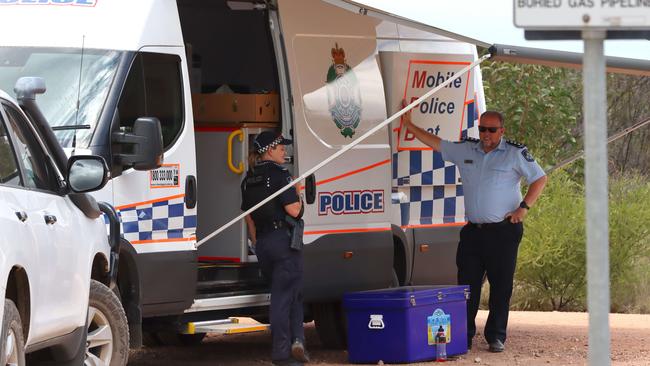
Constable Owen said the two police vehicles reversed for several hundred metres before completing a U-turn and turning down a driveway.
He said they told people at that property to get away because there was an active shooter incident underway nearby.
He told the inquest he believed they could be no help to the police stranded on the Train property at that time.
After evacuating the residents, the three officers retreated to the command post nearby.
CREW THOUGHT OTHER OFFICERS HAD ARRIVED
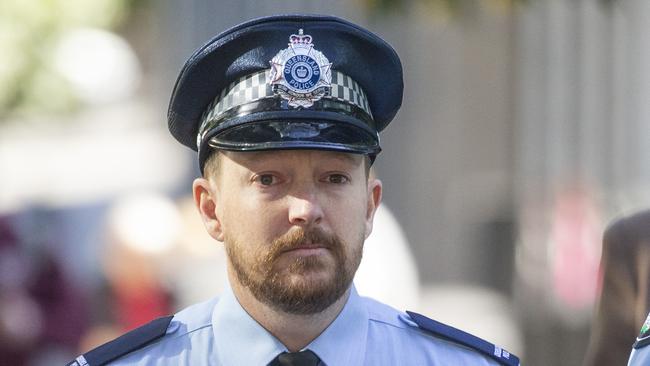
Officers revealed they drove within metres of the property where conspiracy theorists had just murdered their colleagues because they misheard a crackly radio that sounded like another crew had just arrived who might need help.
Constable Christopher Sharman was one of the first three officers to the scene to respond to the murders of police constables Rachel McCrow and Matthew Arnold.
When he arrived near the scene with Dalby colleague Constable Mathew Owen they met with Tara police station Constable Craig Loveland.
They began putting on their ballistic vests when they heard communications over the radio.
“During that time there was a radio communication that came through crackly, that was broken,” Const Sharman told the inquest.
He said the broken communication came through suggesting another crew was “off the job” at the Wains Rd address where the Train trio had murdered the police officers.
The communication suggested to Constable Sharman that another crew had just arrived at the address. Instead of staying away from the location they decided to investigate.
“If somebody had been off at the actual address taking fire we didn’t not want to provide assistance,” Constable Sharman said.
“We decided to go down to the incident location and confirm that there was no crew there under fire, or who required urgent assistance.”
Constable Sharman said when the officers arrived it became clear no other crew was there and they had misheard the radio communications.
SLAIN OFFICERS CALLED IN EARLY ON DAY OF SHOOTING
A Tara police officer has revealed it was not unusual to find “blocks” in the area with “keep out” signs, warnings that trespassers would be shot and even man traps containing spikes.
Constable Craig Loveland has described working in the Western Downs – particularly on shift as a single officer – where there are areas of radio black spots.
“It’s a low socio-economic district … a lot of drug use,” the officer, who worked at Tara station with murdered constables Arnold and McCrow said.
Constable Loveland said he had been advised by his officer-in-charge to conduct careful risk assessments before visiting the “blocks” and consider calling in a second officer before visiting such properties.
“They’d put on a sign, ‘don’t enter or you’ll be shot’,” he said.
“Certain addresses in the blocks … had man traps, booby traps. You’d find pits, spikes, other things around the blocks on certain properties generally … to injure persons entering.”
Constable Loveland said some properties were flagged on the police system as being known to have booby traps.
He described the events that unfolded on December 12, 2022 – the day of the Wieambilla massacre – revealing he was on the early shift alone but was forced to call in both constables Arnold and McCrow before their afternoon shifts were due to start.
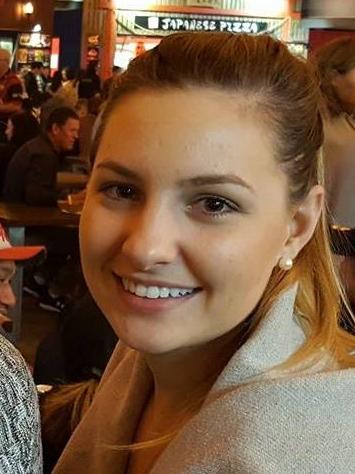
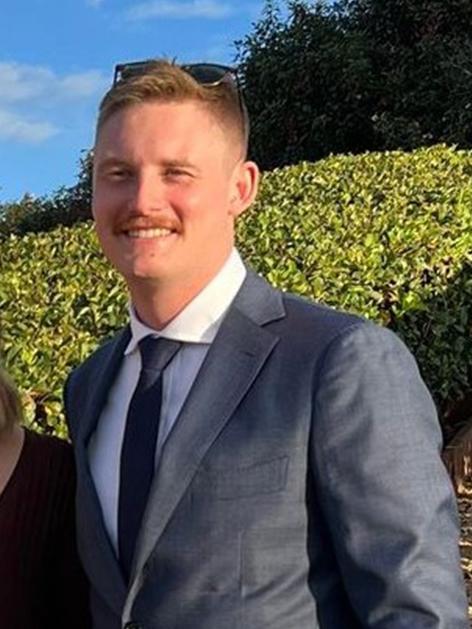
He said he began his shift at 8am and took the police Land Cruiser to be serviced.
Back at the station, he took three separate reports from people who came to the front counter – a rape, an indecent treatment of a child and a report of threats being made.
After that, he received a Code 2 call for a domestic violence incident in the Weranga State Forest area.
He told the inquest that given this was a known communications black spot, he was forced to call Constable Arnold to come in early to accompany him.
He told the inquest he collected the Land Cruiser from the mechanic and he and Constable Arnold attended the domestic violence incident.
After taking a person into custody, he said a second Code 2 job came through – this time an attempted suicide.
“What we did was, because we had the male in custody … I recalled Constable McCrow to duty to assist in guarding the male in custody,” Constable Loveland said.
He said Constable McCrow remained at the station while he and Constable Arnold attended a local hotel.
After that, a third Code 2 job came in.
Constable Loveland said on this occasion, Constables Arnold and McCrow drove out to Weranga while he remained at the station.
He told the court that once that job was finished and his colleagues returned, he spoke to them about a missing person welfare inquiry at Wieambilla that had been added to the dispatch system.
OFFICER HELD UP BY DEFECTIVE CAR BATTERY
A TARA police officer who heard his colleagues had been shot was not able to start a car to get to the scene because of a defective battery, an inquest has been told
Constable Craig Loveland, who was working at Tara station, said he put on a ballistic vest after hearing about the shooting over the radio.
He tried to take the car to the scene but it wouldn’t start.
“I had to reconnect the battery,” Constable Loveland told the inquest.
“It was discharging, it had an electrical problem.
“I had to unlock it, pop the bonnet, reconnect the negative terminal so I could start the vehicle,” he said.
The officer said there had been an electrical problem with the car for months but mechanics could not find the problem.
Constable Loveland also told the inquest that it would be usual for officers to enter a property if there was a locked gate, regardless of “no entry” signs, as part of a missing persons inquiry.
He described how part of his duties at Wieambilla that night involved accompanying the district duty officer and another constable in a car to block the Trains’ driveway.
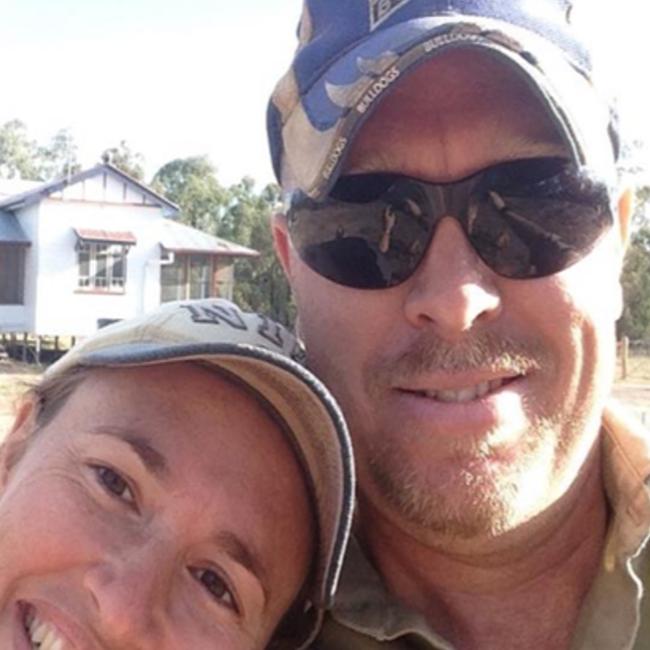
He told the inquest the purpose of this was to prevent them escaping in one of their own vehicles.
The officer said he believed this happened after an extraction team had gone onto the property to get the bodies of his murdered colleagues.
He said after getting out of the car, several shots were fired in their direction.
“Did you believe they were being fired at you?” counsel assisting the coroner Ruth O’Gorman KC asked.
“Yes,” he replied.
“As in hostile gunshots towards you?” she said.
“Yes,” he said.
Constable Loveland said they used the vehicle as cover while escaping on foot but acknowledged there was little other cover.
“You could hear the bullets go overhead,” he said.
“You could hear them zip overheard.”
Constable Loveland said while there, he saw the body of Mr Dare.
“He wasn’t moving. He looked very pale,” he said.




